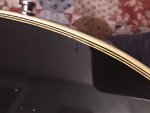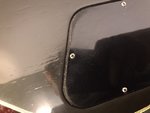Mr. Willy":p2immnt2 said:
I should also add...if you look at some of the pics of the back, those little white spots...it’s trash or something in the finish. It’s literally imbedded in the finish.
I'm a long time lurker and your thread motivated me to register so I could share my thoughts on what went wrong. I had a superstrat style guitar completely refinished about 20 years ago. It was the first nice guitar I owned and had alot of sentimental value, although not as much cash value as your LP. I had done some work on it previously, had tinkered with it, altered the finish. It had been leveled many times, needed a refret, and the maple board was scarred and marked up by thousands of hours of playing.
Like you, I wasn't completely happy with the outcome. But I understood that based on the condition I gave it to him, it wouldn't come back as new. (And I only spent 600 on a refret and refinish, which I thought was a fair deal, probably close to 1000 in today's dollars, and very close to what I paid for the guitar new.) I had removed the thick poly factory finish with the expectation that I'd refinish it myself, but I didn't have the tools or skill to do a good job, so I gave the unfinished project to him to finish.
My objective here is to help moderate your emotions so you can find a middle ground and enjoy your guitar again.
I want to be supportive, and I agree the work isn't the best (or at least wouldn't meet my expectations if I was expecting a "new" looking guitar), but there are a few things that stand out in your correspondence.
The thing that you kept saying is that you wanted the guitar "to look as good as it can". And in his invoice he referred to it as "aged" look. So its clear to me that in the original dialogue, there was an acknowledgement that it wouldn't be perfect. And it seems that he took on the job with that understanding (and perhaps used that as justification to cut some corners). IMO, if you wanted it to look like a mint frampton guitar, you should have used dialogue to that effect. That may have altered his quote, or it may have given him pause to even do the work at all.
I'm saying this not to inflame, but reading the correspondence, it sounds to me like on the front side of the transaction, you were laid back and said "make it look as good as it can (I know its in bad shape)" and on the back side of the transaction you got very particular about it. And I'm not saying that you're wrong to do this, because the quote nearly doubled.
What I can relay about my own refinished guitar is that when it came back, it did not sound as good as it did before (or at least not the same). I had removed the thick factory poly finish and when they refinished it, the guitar had a "lighter/warmer" tone. Additionally, some of the wood grain indentations were showing through the new finish (like an old Fender might), so it didn't have that new/perfect "spaceship" look like many superstrats.
It may be that the finishing approach that he took on your guitar was historically accurate, the exact finishing technique used on new LPs of that era, but because the wood had been exposed, as he said, there ended up being imperfections in the final finish. In his mind this probably fell under "make it look as good as it can".
The alternative to this approach, to fill every imperfection, spray it with primer, sand, spray, sand, spray, etc could have made the guitar look "perfect", but would have been a different technique that was not historically accurate and that (more importantly) would have altered the tone of your instrument. And it might also have added additional labor.
The other thing that stands out to me, (that in hindsight I think you will agree would have been a better way to handle this), was that you went to the forums for feedback on the work instead of contacting other luthiers to get their take. It may be that another luthier could have looked at this and confirmed that it is bad work, or at least explained why it came out the way it did, based on the original requirements. Armed with that information, you would be better prepared to argue your case with the original luthier or credit card company.
The most important thing is for you to enjoy your guitar again. I would point out that if it still has the same great sound, that is something in itself; refinishing can definitely change the sound. If it came back "perfect" he may have had to use a different technique, sprayed more coats, and that could have changed the tone and even made it look "incorrect" in other ways.
Regarding the file marks on the board, I didn't see anything in the original invoice about re-radiusing the neck. I wasn't able to match up the photos you provided to see if there was an A/B difference proving that he was responsible for file marks. I will just have to believe you that they weren't there before. If they are just tool marks from crowning/leveling and if it bothers you, I think you could get them worked out for a minimal fee with another luthier. I don't think there is any chance of getting the original guy to sand them out at this point.
Good luck, I hope you can get to a place where you enjoy the guitar again.




